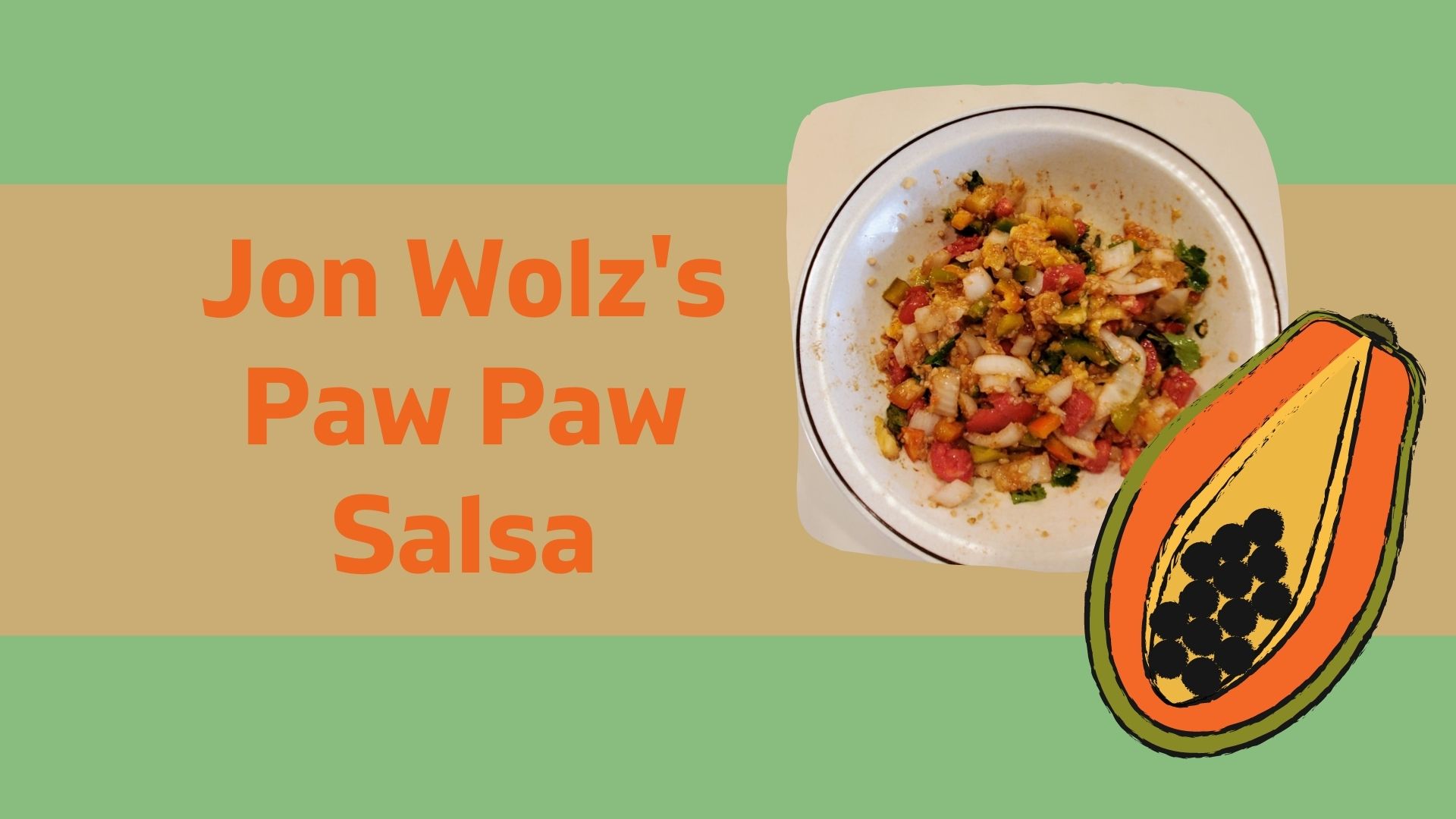Written by Jon Wolz
It is that time of year again. What I am I talking about? Paw paws are ripening along the Potomac River. This year, I thought when I gather my paw paws, I would attempt to make paw paw salsa using a recipe my friend Bernie Doerner gave me.
Paw paws are the largest edible fruit native to North America. They can measure from a few inches up to six inches long with large, dark brown seeds and soft, pale green flesh, the fruit has a sweet flavor that is often compared to pineapple, mango, banana or cantaloupe. The fruit has the consistency of “custard”. In Maryland, they are sometimes called, “Maryland” bananas.
The earliest documented mention of paw paws is in the 1541 report of the Spanish de Soto expedition, who found Native Americans cultivating it east of the Mississippi River. The Lewis and Clark Expedition consumed paw paws during their travels. Chilled pawpaw fruit was a favorite dessert of George Washington.
The fruits of the pawpaw are eaten by a variety of mammals, including raccoons, foxes, opossums, squirrels, and black bears. Larvae of the zebra swallowtail feed exclusively on young leaves. While paw paws are larval hosts for the zebra swallowtail butterfly, these caterpillars are usually present only at low density, and not detrimental to the foliage of the trees.
Soft paw paws are ripe, whereas a hard paw paw is not ripe. Unripe, hard paw paws will not ripen once they are on the ground. I learned not to bother with these. I look for those that I can squeeze, and my fingertips can push into the ripe fruit a little.
My search for paw paws took me to Edward’s Ferry (lock 25) along the C&O Canal. Paw paw trees are found all along the Potomac River in Montgomery County. I walked down the towpath to the bridge on the towpath that is two-tenths of a mile down from the lock. The bridge goes over what was once a water filled prism that led to the Goose Creek River Lock. The prism leading to the lock is about a couple of hundred feet long. The Goose Creek River Lock is at mile 30.84 along the towpath. It was a two-lift lock combination leading from the Potomac River. Water entered the lock from the Canal prism. During Canal operating days, the two locks were joined by a middle set of lock gates. Each lock is 90’ long. The locks were completed in 1838 to accommodate boats coming across the Potomac River from Goose Creek, Virginia.
The coping stones of the locks are Aquia freestone; other stones are roughly cut, roughly faced and roughly coursed Seneca sandstone. There was a raised mule bridge over the “inlet” connecting the C&O Canal that allowed boats to pass underneath it. The “inlet” is about two hundred feet long leading from the locks to the C&O Canal prim. The lock keeper at lock 25 also had responsibility for tending the Goose Creek inlet lock.
During the Civil War, Confederates retreating from Washington, DC, burned and dumped the bridge into the Canal in 1864. The bridge was replaced by wooden planking over the opening in the wall of the Canal connecting the channel to the Goose Creek River Lock. In the early 1900s a
four-gate waste weir was built at the upper end of the locks that was constructed after the river locks were abandoned. This waste weir replaced the wooden gate at the lock. The remains of the waste weir is still evident. Today, there is a wooden bridge over the opening in the Canal wall at the entrance of the basin that leads to the river lock.
Today, trees/roots and underbrush are damaging or threatening the stone walls of this river lock. Also, there is thick undergrowth growing at the base of the lock in sections. Trees and vegetation are threatening to overtake this historic Canal structure and permanently erase it from the C&O Canal landscape. Also, Potomac River flooding has deposited tree debris in both of the locks.
There are many local and out of area visitors to Edward’s Ferry who go by this area just down from lock 25. It would be nice to preserve and maintain this unique Canal lock. After my recent visit, I prepared and submitted a special project request to the C&O Canal Association asking that I be allowed to pursue bids from contractors who could clean out the Goose Creek Inlet Lock.
After spending time examining the inlet lock, I walked off into the woods to hunt for paw paws. I had difficulty finding paw paws. There were not as many paw paws this year as compared to last year. Maybe the blossoms were affected by the May freeze. I was able to gather eight paw paws and when I got home, I put them in the refrigerator. A few days later, I made the paw paw salsa and it was delicious!
Paw Paw Salsa Recipe
1/3 cup ripe paw paws
1 1/3 cup beefsteak or roma tomatoes
1/3 cup white or yellow onions
½ green pepper
2 tablespoons lemon juice
1 teaspoon cumin powder
¼ teaspoon red chili pepper
2 cloves garlic minced
1 ½ teaspoons fresh cilantro
Salt to taste
Toss everything
If you missed Jon’s recent presentation “The History of the C&O Canal” check it out on our YouTube;

